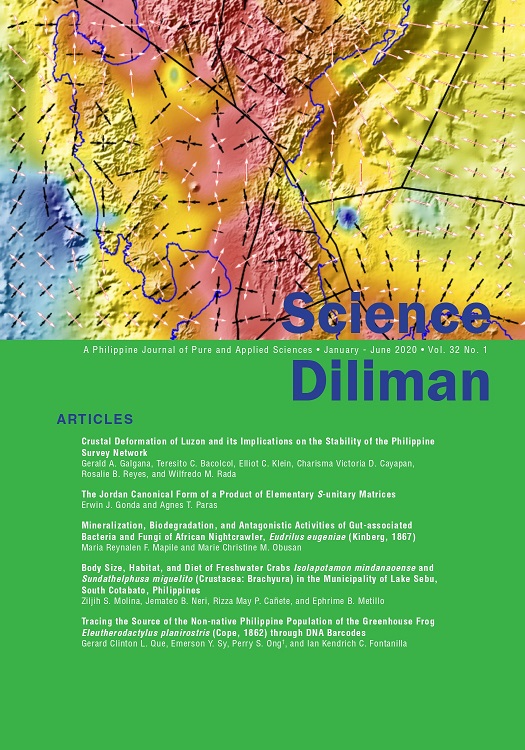Body Size, Habitat, and Diet of Freshwater Crabs <em>Isolapotamon mindanaoense</em> and <em>Sundathelphusa miguelito</em> (Crustacea: Brachyura) in the Municipality of Lake Sebu, South Cotabato, Philippines
Abstract
Isolapotamon mindanaoense (Rathbun 1904) and Sundathelphusa miguelito Mendoza and Sy 2017 have narrow biogeographical distribution and are both regarded as endemic to Mindanao island. They are common and publicly consumed freshwater or semi-terrestrial crabs inhabiting vicinities near the waterfalls of Lake Sebu Municipality, South Cotabato in Mindanao, but both species are scarcely investigated. This study aimed to examine the body size, microhabitat and the feeding ecology of these freshwater crab species. Sex and carapace width and length of individuals were determined from specimens collected by hand at three waterfall sampling sites. Feeding and feeding niche overlap were respectively analyzed using the index of relative importance (IRI) of prey items from individual crab stomachs and the Schoener’s Ro index. Food items ingested include fish fragments, insect body parts, fragments of aquatic vascular plants, freshwater algae, sand grains and amorphous materials, and these items were similar between species. However, the larger I. mindanaoense appeared to ingest more fish fragments and other animal prey items compared to S. miguelito which ingested more amorphous materials that are derived from benthic plants. However, the Ro value of 93% was high, suggesting very similar diet. The two species further partition niches, with S. miguelito being smaller in size and inhabiting sand and gravel substrate, while the larger I. mindanaoense inhabit areas with big boulders. Hence, the crabs can be categorized as omnivorous and detrivorous, and exhibit feeding and habitat niche partitioning that alleviate possible resource competition between the two species.
Published
2020-09-17
How to Cite
MOLINA, Ziljih S. et al.
Body Size, Habitat, and Diet of Freshwater Crabs Isolapotamon mindanaoense and Sundathelphusa miguelito (Crustacea: Brachyura) in the Municipality of Lake Sebu, South Cotabato, Philippines.
Science Diliman: A Journal of Pure and Applied Sciences, [S.l.], v. 32, n. 1, sep. 2020.
ISSN 2012-0818.
Available at: <https://journals.upd.edu.ph/index.php/sciencediliman/article/view/7216>. Date accessed: 01 oct. 2025.
Issue
Section
Articles
Keywords
Mindanao, feeding ecology, IRI, omnivory, niche partitioning, diet
Submission of a manuscript implies: that the work described has not been published before (except in the form of an abstract or as part of a published lecture, review, or thesis); that it is not under consideration for publication elsewhere; that its publication has been approved by all co-authors, if any, as well as by the responsible authorities at the institute where the work has been carried out; that, if and when the manuscript is accepted for publication, the authors agree to the automatic transfer of the copyright to the publisher; that the manuscript will not be published elsewhere in any language without the consent of the copyright holders; that written permission of the copyright holder is obtained by the authors for material used from other copyrighted sources; and that any costs associated with obtaining this permission are the authors’ responsibility.



